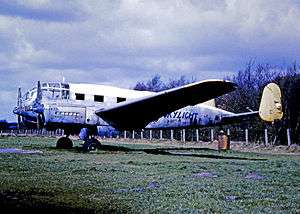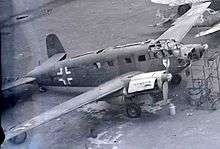Siebel Si 204
| Si 204 | |
|---|---|
 | |
| Siebel Si 204D PH-NLL displayed at Hilversum Airport in 1967 | |
| Role | Light transport/trainer |
| National origin | Germany |
| Manufacturer | Siebel |
| Primary users | Luftwaffe Czechoslovakia France |
| Number built | 1,216 (to January 1945) |
| Developed from | Siebel Fh 104 |
The Siebel Si 204 was a small twin-engined transport and trainer aircraft developed during World War II. It was based on the Fh 104. Originally designed in response to an RLM development order for a small civil transport aircraft in 1938, it was eventually produced for the Luftwaffe.

Development and production

The Si 204 was planned as a small all-metal passenger aircraft with 2 crew and 8 passengers for German airline Deutsche Luft Hansa (DLH). Development was initiated in 1938. The contractor was, as usual, the RLM, but the development was conducted in close collaboration between DLH and Siebel in Halle. After the beginning of the war the aircraft was re-designed as a trainer aircraft with a full "stepless" glass cockpit, with no separate flat windscreen for the pilot (much as almost all German bomber aircraft of the time were being designed), which seemed to be better for blind flying in the Si 204's case.
The first two prototypes only were delivered as passenger aircraft with the old cockpit. The maiden flight of the first prototype was before September 1940, possibly on 25 May 1940, that of the second prototype before February 1941. The third prototype was re-designed as a trainer aircraft for blind flying. As a result of this, the maiden flight was not earlier than the end of 1941 or the beginning of 1942.
At that time Siebel produced the Junkers Ju 88 under licence, and therefore only 15 prototypes were able to be built in Halle. As a result, SNCAN (Société Nationale de Constructions Aéronautiques du Nord)) in France produced the A-0 pre-series A-1 production passenger aircraft between April 1942 and November 1943. Českomoravská Kolben-Daněk (ČKD) / Böhmisch-Mährische Maschinenfabrik AG (BMM) in the Czech Protectorate delivered the first blind flying trainer D-0 in January 1943 followed by the production of a further 44 D-0 pre-series aircraft. The D-1 series was begun in March 1943 by the Aero company, also located in the Czech Protectorate, and by BMM in June or July 1943. In August 1943, SNCAN also delivered their first D-1.
The production of the D-3 was started in October 1944 by the Aero company. The D-3 had wooden wings and a tail-plane made of wood and metal. In France, production of the D-1 was ended in August 1944 as a result of the Liberation. SNCAN produced a total of 168 units of the Si 204. BMM produced the aircraft until October 1944 and then changed to producing spare parts for the Si 204. The Aero company was scheduled to cease production of the D-1 in March 1945 after building 486 aircraft and then switch to D-3 only. The aircraft, however, was only built until January 1945 with 541 completed. Therefore the total production was 1,216 (until January 1945) including the prototypes; some production in other countries continued after the war ended.
Variants
- Siebel Fh 104
- Precursor to the Si 204 family, with a stepped windscreen and slightly smaller dimensions.
- Si 204
- Prototypes each given a separate V number; Fifteen built by Siebel at Halle.
- Si 204A
- Pre-production A-0 and initial production A-1 passenger transports built at SNCAN ((Société Nationale de Constructions Aéronautiques du Nord) in France.
- Si 204D
- A blind flying trainer developed by ČKD / BMM in the Czech Protectorate; the first D-0 pre-series aircraft was delivered in January 1943 plus another 44. Production of the D-1 was carried out by Aero and BMM. D-3 aircraft were built with wooden wings and tailplanes in an effort to relieve pressure on the Aluminium supply.
- Aero C-3
- Postwar production in Czechoslovakia for flying (C-3A) and crew training (C-3B).
- Aero C-103
- Civilian passenger transport variant.
- Aero D-44
- military transport variant.
- SNCAC NC.701 Martinet
- Military transport powered by two SNECMA 12S-00 inverted air-cooled V-12 engines.
- SNCAC NC.702 Martinet
- Passenger transport version with stepped windscreen.
Production figures of the Si 204 until 31 January 1945:
| Version | Siebel | SNCAC | BMM/ČKD | Aero | SUM |
|---|---|---|---|---|---|
| Prototypes | 15 | 15 | |||
| A-0 | 30 | 30 | |||
| A-1 | 85 | 85 | |||
| D-0 | 45 | 45 | |||
| D-1 | 53 | 447 | 477 | 977 | |
| D-3 | 64 | 64 | |||
| SUM | 15 | 168 | 492 | 541 | 1.216 |
Sources: Files from Federal Archive/Military Archive Freiburg and from Lufthansa-Archive, Cologne
After the war, a production of Si 204 continued in Czechoslovakia and France. In Czechoslovakia Aero Vodochody produced 179 Si 204D, developed into military trainer variants Aero C-3A and C-3B (the latter for bombardier training), passenger variant C-103 and military transport variant Aero D-44 until 1949. In France SNCAC (Société Nationale de Constructions Aéronautiques du Centre), commonly known as Aérocentre, produced 240 transport NC.701 Martinets and a number (110?) of passenger NC.702 Martinets.[1] The NC.701 was distinguished by three-blade propellers and was powered by 440 kW (590 hp) Renault 12S-00 engines. The NC.702 had a modified nose.[2]
Operational history

The Si 204D was used mainly in B- and C-Schools (advanced schools) and in FÜG 1 (delivery wing of the Luftwaffe), probably as a taxi aircraft for crews who had delivered other aircraft to fighting units. The utilization in blind flying schools was sporadic; for radio schools there is no evidence of use. The Si 204A flew mainly with communications squadrons and flying services for senior officers, but also with schools.
In July 1944 five Si 204 were destined to be converted to night combat aircraft, but no further aircraft were allotted. They were probably intended for the pre-series Si 204 E-0. There is, however, no evidence that these aircraft were ever used in combat situations.
Luft Hansa received at least four Si 204: The first prototype, D-AEFR, was evaluated from March to May 1941 by Luft Hansa Prague. From spring 1942 to spring 1943 the second prototype, D-ASGU, was used on regular routes as a freight carrier.
An Si 204 was likely the last German aircraft shot down on the Western Front. At 8 PM on May 8, 1945, 2nd Lt. K. L. Smith of the 9th Air Force's 474th Fighter Group, flying a P-38 Lightning, downed a Siebel three miles southeast of Rodach, Bavaria.[3]
At the end of the war one Si 204D remained in Berlin-Tempelhof (named “Rhein”). One flew to Enns in Austria, where it was captured by the Allies. Captured Si 204s flew in a variety of roles in the Soviet Union, including with Aeroflot and TsAGI, but were all quickly phased out of service as local aircraft manufacturing was re-established.
Prototypes of the Si 204
| Version | Engine | Usage | First Flight | Fate |
|---|---|---|---|---|
| V1 | As 410 | Prototype passenger plane, Reg. D-AEFR | 25 May 1940? | Not mentioned in November 1942, scrapped? |
| V2 | As 410 | Prototype passenger aircraft, Reg. D-ASGU | Before February 1941 | 26.02.44 Crash Erprobungs-Stelle Rechlin |
| V3 | As 410 | Prototype Blind flying training aircraft | Before February 1942 | 01.06.42 Crash Erprobungs-Stelle Rechlin |
| V4 | As 411 | Prototype Blind flying training aircraft, Reg. KM+GB | Before November 1942 | |
| V5 | For stress testing | |||
| V6 | As 410 | Evaluation As 410 | December 1942 | |
| V7 | As 410 | Weather reconnaissance | ||
| V8 | As 410 | General flight evaluation | ||
| V9 | As 410 | General flight evaluation | 30.06.43 Crash School C-16 Burg | |
| V10 | As 410 | General flight evaluation | ||
| V11 | As 410 | General flight evaluation | ||
| V12 | As 410 | General flight evaluation | 13.03.44 Crash Erprobungs-Stelle Rechlin | |
| V13 | As 410 | General flight evaluation | ||
| V14 | As 411 | Prototype D-2 | ||
| V15 | As 411 | Evaluation As 411 |
Operators
Military Operators
- Czechoslovakian Air Force operated ex-Luftwaffe Si 204 as well as Aero C-3 built in Czechoslovakia post war.
- Czechoslovakian National Security Guard
- French Air Force operated ex-Luftwaffe Si 204 as well as NC.701 built in France post war.
- French Navy
- Luftwaffe
- Hungarian Air Force operated six Aero C-3s from 1947 to 1953.
- Polish Air Force operated six NC.701s (received from LOT airlines) from 1949 to 1955 for aerial photography[4]
- Soviet Air Force operated several captured Si 204.
Civil Operators
- ČSA operated post-war built Aero C-103s.
- Deutsche Luft Hansa operated at least four aircraft.
- Nationaal Luchtvaart Laboratorium (NLL) (NLL Dutch National Aeronautical Laboratory) operated one Si 204D-1 (BMM built) from 1946 till 1964, registered PH-NLL.
- Polskie Linie Lotnicze LOT operated in 1947-1948 six NC.701 bought in France. Aircraft were used for aerial photography and had markings from SP-LFA to LFF.[4]
- Rikets Allmänna Kartverk operated five NC.701 bought in France between 1962-1970 for mapping photography.
- Aeroflot operated post war some captured Si 204 for transport duties.
Specifications (Si 204)
General characteristics
- Crew: one or two pilots
- Capacity: up to 8 passengers or up to 1,650 kg (3,638 lb) cargo
- Length: 13.00 m (42 ft 8 in)
- Wingspan: 21.33 m (70 ft 0 in)
- Height: 4.25 m (14 ft 0 in)
- Wing area: 46 m² (495 ft²)
- Empty weight: 3,950 kg (8,709 lb)
- Max. takeoff weight: 5,600 kg (12,348 lb)
- Powerplant: 2 × Argus As 411-A1 air-cooled V12 engines, 441 kW (592 hp) each
Performance
- Maximum speed: 364 km/h (228 mph)
- Range: 1,400 km (875 miles)
- Service ceiling: 6,400 m (20,992 ft)
- Rate of climb: 360 m/min (1,181 ft/min)
See also
- Related development
- Aircraft of comparable role, configuration and era
- Related lists
References
Notes
Bibliography
- Franzke, Manfred. Siebel Fh.104/Si.204 varianten. Ilterissen, Germany: Flugzeug Publikations GmbH, 1997
- Griehl, Manfred. The Luftwaffe Profile Series No. 11: Siebel Fh 104/Si 204 and its variants. Atglen, PA: Schiffer Publications, 1998. ISBN 0-7643-0566-2
- Jońca, Adam. Samoloty linii lotniczych 1945-1956 Warszawa, Poland: WKiŁ, 1985. ISBN 83-206-0529-6
- Smith, J.R. and Kay, Antony J. German Aircraft of the Second World War. London: Putnam, 1990. ISBN 0-85177-836-4
External links
| Wikimedia Commons has media related to Siebel Si 204. |